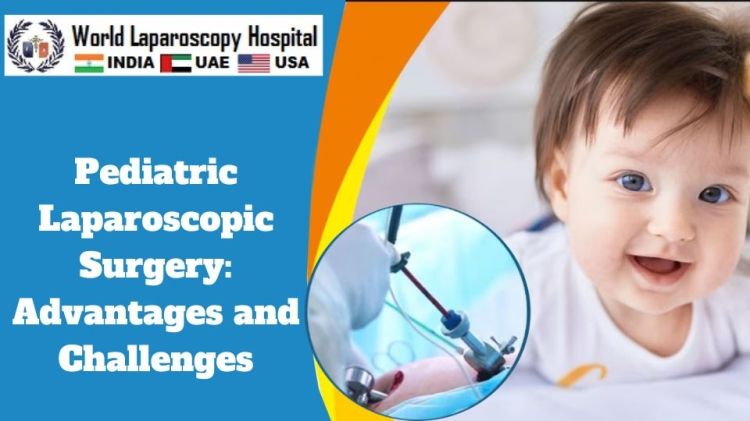Title: Pediatric Laparoscopic Surgery: Advantages and Challenges
Introduction
Pediatric surgery has come a long way in recent decades, thanks to advancements in medical technology and techniques. One such breakthrough in the field of pediatric surgery is laparoscopic surgery. Laparoscopic surgery, also known as minimally invasive surgery, has gained popularity for its numerous advantages in treating a wide range of conditions in children. However, like any medical procedure, it also presents its own set of challenges. In this article, we will delve into the world of pediatric laparoscopic surgery, exploring its advantages and addressing the challenges that surgeons may encounter.

Advantages of Pediatric Laparoscopic Surgery
Minimized Surgical TraumaOne of the primary advantages of laparoscopic surgery in pediatrics is its minimally invasive nature. Traditional open surgeries involve large incisions, which can result in significant trauma to the child's body. In contrast, laparoscopic procedures require only small incisions, typically less than half an inch in size. This minimizes the trauma to the child's tissues and muscles, leading to faster recovery times and reduced postoperative pain.
Enhanced Cosmetic OutcomesThe smaller incisions used in laparoscopic surgery lead to improved cosmetic outcomes. Unlike open surgery, which often leaves large scars, laparoscopic incisions are tiny and less noticeable. This is especially important in pediatric patients, as it can help boost their self-esteem and body image as they grow and develop.
Reduced Risk of InfectionLaparoscopic surgery also offers a reduced risk of postoperative infections. With smaller incisions, there is less exposure of internal organs to external contaminants, lowering the chances of infection. This is crucial in pediatric patients, who may have weaker immune systems compared to adults.
Shorter Hospital StaysAnother significant advantage of laparoscopic surgery in pediatrics is the shorter hospital stays. Since the procedure is less invasive and typically results in quicker recovery, children can often go home sooner after surgery. This not only reduces healthcare costs but also allows children to return to their normal activities faster.
Faster Return to Normal ActivitiesPediatric patients undergoing laparoscopic surgery can often resume their normal activities more quickly than those who undergo open surgery. This is particularly important for children, as it minimizes disruptions to their daily routines, school attendance, and social interactions.
Improved VisualizationLaparoscopic surgery provides surgeons with a high-definition, magnified view of the surgical site. This improved visualization allows for greater precision during the procedure. Surgeons can better identify and address anatomical structures, leading to safer and more effective surgeries.
Decreased Blood LossCompared to open surgery, laparoscopic procedures generally result in decreased blood loss. This is a crucial advantage, especially in pediatric patients who may have smaller blood volumes. Reduced blood loss during surgery contributes to a lower risk of complications and the need for blood transfusions.
Challenges of Pediatric Laparoscopic Surgery
Technical ExpertisePerforming laparoscopic surgery in pediatric patients requires a high level of technical expertise. Surgeons must undergo specialized training to become proficient in laparoscopic techniques. The instruments used are delicate and require precise manipulation, making the learning curve steeper for some surgeons.
Equipment and CostsLaparoscopic surgery requires specialized equipment and instruments, which can be costly to acquire and maintain. Hospitals and surgical centers need to invest in advanced laparoscopic technology, including high-definition cameras, monitors, and instruments. While the initial investment may be substantial, the long-term benefits in terms of patient outcomes and reduced hospital stays often justify the expense.
Limited Surgical FieldOne challenge specific to laparoscopic surgery in pediatrics is the limited surgical field. Children have smaller abdominal cavities and organs, making it more challenging to perform laparoscopic procedures. Surgeons must adapt their techniques to accommodate the smaller anatomy while maintaining surgical precision.
Patient SelectionNot all pediatric patients are suitable candidates for laparoscopic surgery. Certain conditions or anatomical factors may make open surgery a more appropriate choice. Surgeons must carefully evaluate each case to determine the best approach for the child's specific needs.
PneumoperitoneumIn laparoscopic surgery, carbon dioxide gas is used to create a pneumoperitoneum, which provides a working space for the surgeon. However, this can lead to potential complications, such as gas embolism or increased intra-abdominal pressure. Pediatric patients may be more susceptible to these risks, necessitating close monitoring during the procedure.
Ergonomic ChallengesPerforming laparoscopic surgery can be physically demanding for surgeons, as they need to maintain awkward positions for extended periods while manipulating instruments through small incisions. This can lead to ergonomic challenges and the risk of surgeon fatigue.
Conclusion
Pediatric laparoscopic surgery offers numerous advantages, including minimized surgical trauma, enhanced cosmetic outcomes, reduced risk of infection, shorter hospital stays, faster return to normal activities, improved visualization, and decreased blood loss. These benefits have revolutionized the field of pediatric surgery and improved outcomes for young patients.






